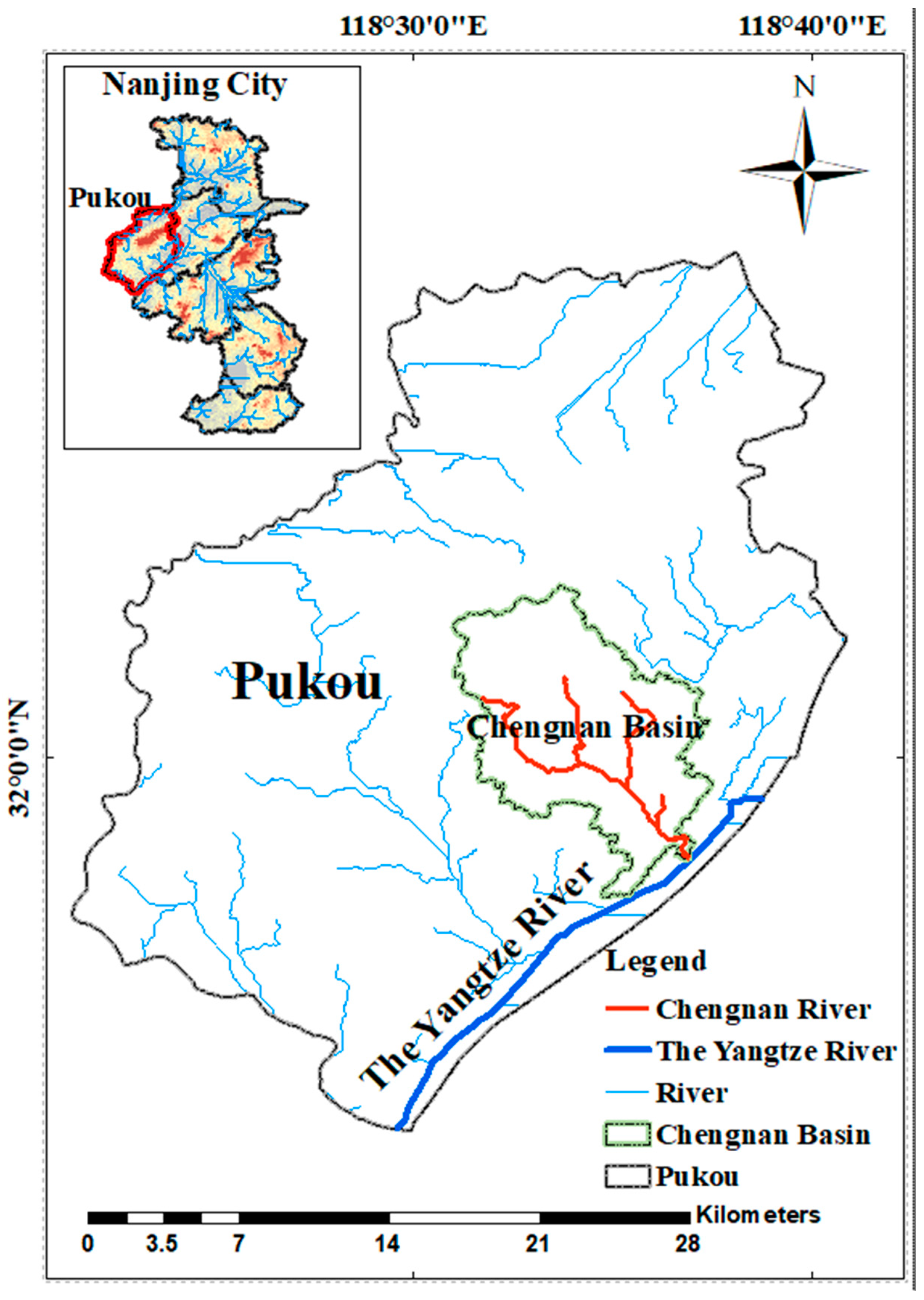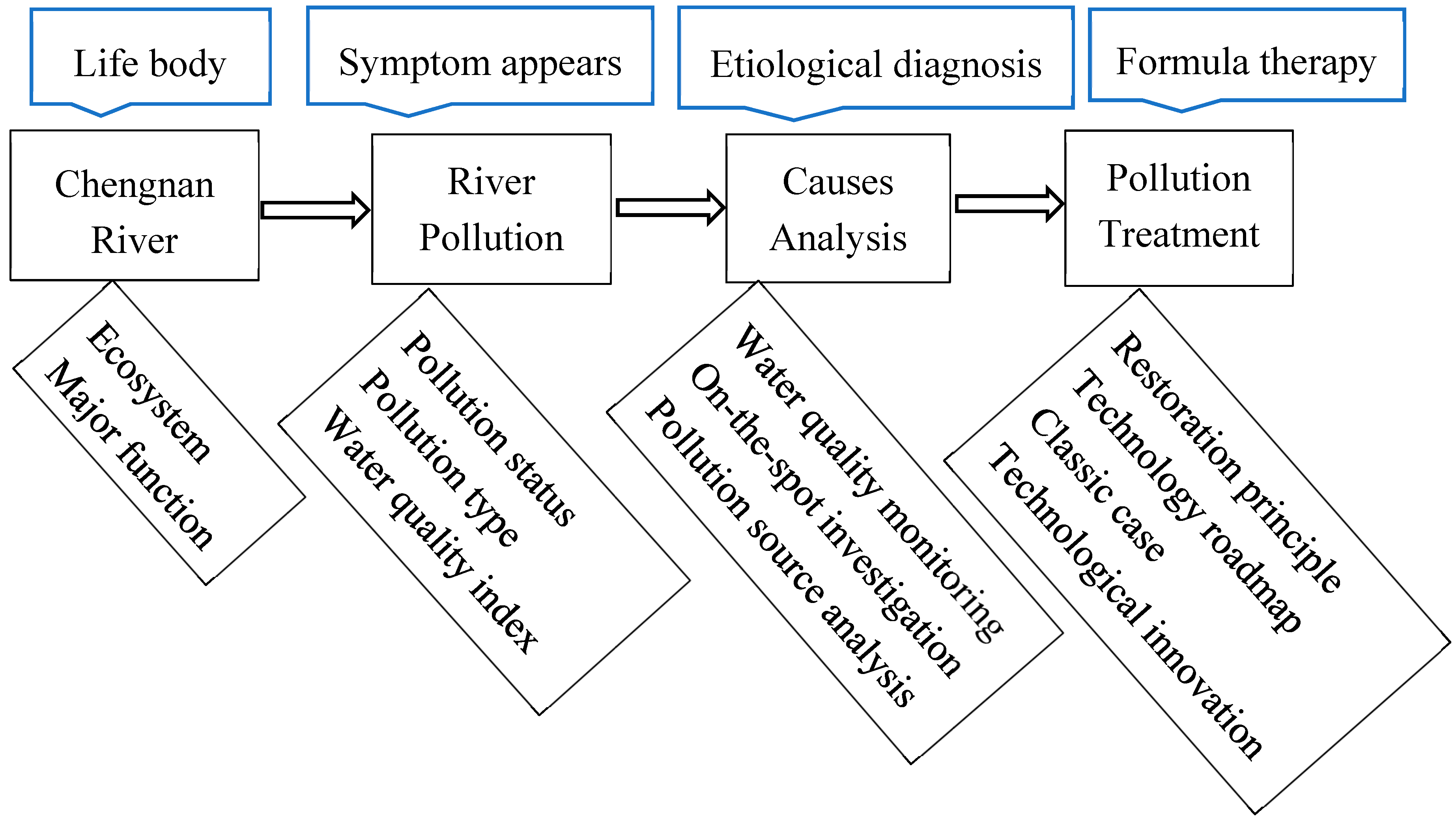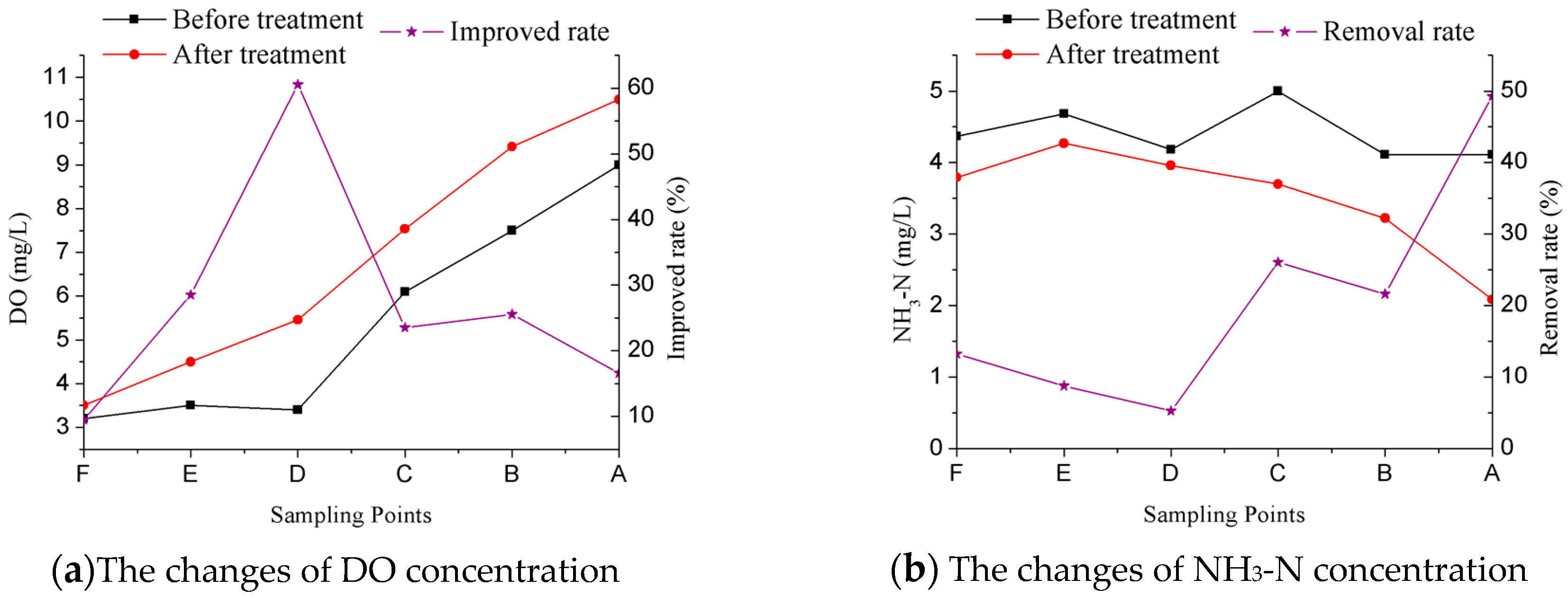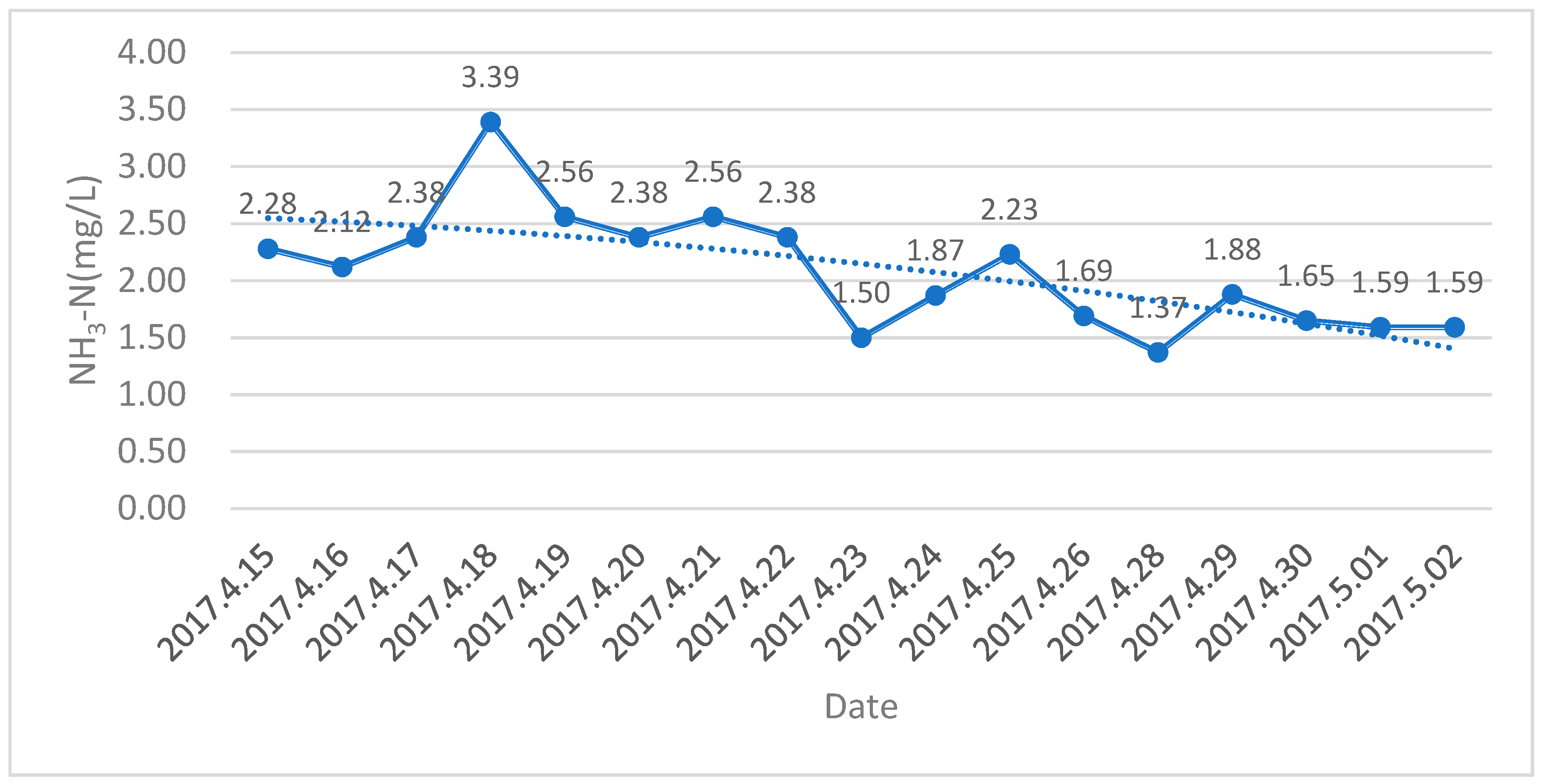Application of Microbial Technology Used in Bioremediation of Urban Polluted River: A Case Study of Chengnan River, China
Abstract
:1. Introduction
2. Materials and Methods
2.1. Study Area
2.2. Main Microbial Agent
2.2.1. HP-RPe-3 Microbial Agent
2.2.2. Microbial Accelerating Agent
2.3. Methods
2.3.1. Microbial Technology Treatment Process
2.3.2. Water Quality Indices Evaluation Methods
3. Results and Discussion
3.1. Analysis of Single Factor of Water Quality
3.2. Analysis of Nemerow Index
3.3. Analysis of Fuzzy Comprehensive Evaluation Index
4. Conclusions
Author Contributions
Funding
Acknowledgments
Conflicts of Interest
References
- Unesco, P.E.; Wmo, G.E. International Glossary of Hydrology; World Meteorological Organization (WMO): Geneva, Switzerland, 1992. [Google Scholar]
- Saeijs, H.L.; Van Berkel, M.J. Global water crisis: The major issue of the 21st century, a growing and explosive problem. Eur. Water Pollut. Control Off. Publ. Eur. Water Pollut. Control Assoc. 1995, 5, 26–40. [Google Scholar]
- Linton, J.I. Global hydrology and the construction of a water crisis. Great Lakes Geogr. 2004, 11, 1–13. [Google Scholar]
- BellieSivakumar. Water crisis: From conflict to cooperation—An overview. Int. Assoc. Sci. Hydrol. Bull. 2011, 56, 531–552. [Google Scholar]
- De Azevedo, L.G.T.; Gates, T.K.; Fontane, D.G.; Labadie, J.W.; Porto, R.L. Integration of water quantity and quality in strategic river basin planning. J. Water Resour. Plann. Manag. 2000, 126, 85–97. [Google Scholar] [CrossRef]
- Kirshen, P.H.; Strzepek, K.M. Comprehensive Assessment of the Freshwater Resources of the World. Managing Water: Coping with Scarcity and Abundance; American Society of Civil Engineers (ASCE): Reston, VA, USA, 1997. [Google Scholar]
- Zeng, Z.; Liu, J.; Savenije, H.H.G. A simple approach to assess water scarcity integrating water quantity and quality. Ecol. Indicat. 2013, 34, 441–449. [Google Scholar] [CrossRef]
- Wan, L.; Cai, W.; Jiang, Y.; Wang, C. Impacts on quality-induced water scarcity: Drivers of nitrogen-related water pollution transfer under globalization from 1995 to 2009. Environ. Res. Lett. 2016, 11, 074017. [Google Scholar] [CrossRef]
- Water Resources in China. Available online: http://www.mwr.gov.cn/english/mainsubjects/201604/P020160406508110938538.pdf (accessed on 18 December 2017).
- Hashim, S.; Xie, Y.; Hashim, I. Comparative indices evaluation to restore urban rivers water quality by using bacterial technology. Rev. Kasmera 2015, 43, 198–209. [Google Scholar]
- Wu, Y.; Dai, H.; Wu, J. Comparative study on influences of bank slope ecological revetments on water quality purification pretreating low-polluted waters. Water 2017, 9, 636. [Google Scholar] [CrossRef]
- Wang, M.; Webber, M.; Finlayson, B.; Barnett, J. Rural industries and water pollution in China. J. Environ. Manag. 2008, 86, 648–659. [Google Scholar] [CrossRef] [PubMed]
- Water Resources Management and Protection in China. Available online: http://www.mwr.gov.cn/english/mainsubjects/201604/P020160406507020464665.pdf (accessed on 1 December 2017).
- China Water Resources Bulletin in 2016. Available online: http://www.mwr.gov.cn/sj/tjgb/szygb/201707/t20170711_955305.html (accessed on 1 December 2017).
- Baker, A.; Inverarity, R.; Charlton, M.; Richmond, S. Detecting river pollution using fluorescence spectrophotometry: Case studies from the Ouseburn, Ne England. Environ. Pollut. 2003, 124, 57–70. [Google Scholar] [CrossRef]
- Munafò, M.; Cecchi, G.; Baiocco, F.; Mancini, L. River pollution from non-point sources: A new simplified method of assessment. J. Environ. Manag. 2005, 77, 93–98. [Google Scholar] [CrossRef] [PubMed]
- Fast, A.W.; Moss, B.; Wetzel, R.G. Effects of artificial aeration on the chemistry and algae of two Michigan lakes. Water Resour. Res. 1970, 9, 624–647. [Google Scholar] [CrossRef]
- Ouellet, C. Artificial aeration to increase pollutant removal efficiency of constructed wetlands in cold climate. Ecol. Eng. 2006, 27, 258–264. [Google Scholar] [CrossRef]
- Mulligan, C.N.; Yong, R.N.; Gibbs, B.F. An evaluation of technologies for the heavy metal remediation of dredged sediments. J. Hazard. Mater. 2001, 85, 145–163. [Google Scholar] [CrossRef]
- Wang, Y.; Zhang, W.; Zhao, Y.; Peng, H.; Shi, Y. Modelling water quality and quantity with the influence of inter-basin water diversion projects and cascade reservoirs in the middle-lower Hanjiang river. J. Hydrol. 2016, 541, 1348–1362. [Google Scholar] [CrossRef]
- Wang, Z.; Li, D.; Qin, H.; Li, Y. An integrated method for removal of harmful cyanobacterial blooms in eutrophic lakes. Environ. Pollut. 2012, 160, 34–41. [Google Scholar] [CrossRef] [PubMed]
- Trivedy, R.K. Chemical and Biological Methods for Water Pollution Studies; Environmental Publications: Karad, India, 1984. [Google Scholar]
- Weaver, D.M.; Ritchie, G.S.P. Phosphorus removal from piggery effluents of varying quality using lime and physico-chemical treatment methods. Environ. Pollut. 1994, 84, 237–244. [Google Scholar] [CrossRef]
- Ma, X.; Wang, Y.; Feng, S.; Wang, S. Comparison of four flocculants for removing algae in Dianchi lake. Environ. Earth Sci. 2015, 74, 3795–3804. [Google Scholar] [CrossRef]
- Håkanson, L.; Bryhn, A. Water pollution—Methods and criteria to rank, model and remediate chemical threats to aquatic ecosystems. Q. Rev. Biol. 1999, 26, 225–227. [Google Scholar]
- Liqiang, X.U.; Haixia, Y.U.; Jianghua, Y.U.; Luo, H.; Zhaoxu, L.I. Study on ecological remediation method of purification of rural polluted slow-flow water. In Proceedings of the International Conference on Biological Engineering and Pharmacy, Wuhan, China, 15–17 December 2017. [Google Scholar]
- Guo, W.; Wang, Y.; Wang, H.; Run-Shui, M.A. Water pollution situation and domestic water ecological restoration method research situation. Water Sci. Eng. Technol. 2010, 2, 027. [Google Scholar]
- Li, M.C. The domestic and overseas research development in ecological restoration of water environment. China Water Resour. 2007, 11, 011. [Google Scholar]
- Sun, L.P.; Yang, L.; Hui, J. Nitrogen removal from polluted river by enhanced floating bed grown canna. Ecol. Eng. 2009, 35, 135–140. [Google Scholar] [CrossRef]
- Xie, Y.; Kabobah, A.T.; Song, Y. Bacterial technology as a sustainable solution to polluted urbanized rivers and wastewater treatment systems in China. J. Appl. Technol. Environ. Sanit. 2012, 2, 87–93. [Google Scholar]
- Hashim, S.; Xie, Y.; Bah, A. Beneficial bacteria helpful to restore water bodies. Orient. J. Chem. 2014, 30, 1397–1399. [Google Scholar] [CrossRef]
- Mani, P.; Keshavarz, T.; Chandra, T.S.; Kyazze, G. Decolourisation of acid orange 7 in a microbial fuel cell with a laccase-based biocathode: Influence of mitigating ph changes in the cathode chamber. Enzyme Microb. Technol. 2016, 96, 170–176. [Google Scholar] [CrossRef] [PubMed]
- Hechmi, N.; Bosso, L.; El-Bassi, L.; Scelza, R.; Testa, A.; Jedidi, N.; Rao, M.A. Depletion of pentachlorophenol in soil microcosms with byssochlamys nivea and scopulariopsis brumptii as detoxification agents. Chemosphere 2016, 165, 547–554. [Google Scholar] [CrossRef] [PubMed]
- Zheng, Y.; Wang, X.C.; Dzakpasu, M.; Ge, Y.; Zhao, Y.; Xiong, J. Performance of a pilot demonstration-scale hybrid constructed wetland system for on-site treatment of polluted urban river water in northwestern China. Environ. Sci. Pollut. Res. 2016, 23, 447–454. [Google Scholar] [CrossRef] [PubMed]
- Sheng, Y.; Qu, Y.; Ding, C.; Sun, Q.; Mortimer, R.J.G. A combined application of different engineering and biological techniques to remediate a heavily polluted river. Ecol. Eng. 2013, 57, 1–7. [Google Scholar] [CrossRef]
- Ravikumar, S.; Baylon, M.G.; Si, J.P.; Choi, J. Engineered microbial biosensors based on bacterial two-component systems as synthetic biotechnology platforms in bioremediation and biorefinery. Microb. Cell Factories 2017, 16, 62. [Google Scholar] [CrossRef] [PubMed]
- Bosso, L.; Scelza, R.; Testa, A.; Cristinzio, G.; Rao, M.A. Depletion of pentachlorophenol contamination in an agricultural soil treated with byssochlamys nivea, scopulariopsis brumptii and urban waste compost: A laboratory microcosm study. Water Air Soil Pollut. 2015, 226, 1–9. [Google Scholar] [CrossRef]
- Sheng, Y.; Chen, F.; Sheng, G.; Fu, J. Water quality remediation in a heavily polluted tidal river in Guangzhou, south China. Aquat. Ecosyst. Health Manag. 2012, 15, 219–226. [Google Scholar] [CrossRef]
- Liu, J.; Wu, Y.; Wu, C.; Muylaert, K.; Vyverman, W.; Yu, H.Q.; Muñoz, R.; Rittmann, B. Advanced nutrient removal from surface water by a consortium of attached microalgae and bacteria: A review. Bioresour. Technol. 2017, 241, 1127–1137. [Google Scholar] [CrossRef] [PubMed]
- Idi, A.; Nor, M.H.M.; Wahab, M.F.A.; Ibrahim, Z. Photosynthetic bacteria: An eco-friendly and cheap tool for bioremediation. Rev. Environ. Sci. Bio/Technol. 2015, 14, 271–285. [Google Scholar] [CrossRef]
- Yudianto, D.; Xie, Y.B. Feasibility of bacterial technology for treating a polluted urban streams from the perspective of numerical modelling. Pol. J. Environ. Stud. 2010, 19, 419–427. [Google Scholar]
- Wu, X.; Xie, Y.B. The field application of microbial technology used in bioremediation of urban polluted river. Adv. Mater. Res. 2012, 518–523, 2906–2911. [Google Scholar] [CrossRef]
- Qian, Y.; Migliaccio, K.W.; Wan, Y.; Li, Y. Surface water quality evaluation using multivariate methods and a new water quality index in the Indian River Lagoon, Florida. Water Resour. Res. 2007, 43, 199–212. [Google Scholar] [CrossRef]
- Luo, F.; Guorong, W.U.; Wang, C.; Zhang, L. Application of nemerow pollution index method and single factor evaluation method in water quality evaluation. Environ. Sustain. Dev. 2016, 2, 026. [Google Scholar]
- Jin, J.L.; Wei, Y.M.; Ding, J. Fuzzy comprehensive evaluation model based on improved analytic hierarchy process. J. Hydraul. Eng. 2004, 3, 65–70. [Google Scholar]
- Pan, M.; Zhao, J.; Zhen, S.; Heng, S.; Wu, J. Effects of the combination of aeration and biofilm technology on transformation of nitrogen in black-odor river. Water Sci. Technol. 2016, 74, 655–662. [Google Scholar] [CrossRef] [PubMed]
- Zimmels, Y.; Kirzhner, F.; Roitman, S. Use of naturally growing aquatic plants for wastewater purification. Water Environ. Res. 2004, 76, 220–230. [Google Scholar] [CrossRef] [PubMed]







| Number | Sampling Points | DO mg/L | NH3-N mg/L | TP mg/L | COD mg/L |
|---|---|---|---|---|---|
| F | Shanghe Square | 3.2 | 4.37 | 0.237 | 22.57 |
| E | Caihong Bridge | 3.5 | 4.68 | 0.345 | 67.72 |
| D | Jiangpu Bridge | 3.4 | 4.18 | 0.330 | 64.71 |
| C | Rubber Dam | 6.1 | 5.00 | 0.357 | 57.19 |
| B | Pubing Bridge | 7.5 | 4.11 | 0.250 | 72.24 |
| A | Longwang Temple | 9.0 | 4.11 | 0.141 | 87.29 |
| Classification | DO mg/L | NH3-N mg/L | TP mg/L | COD mg/L | PH |
|---|---|---|---|---|---|
| Grade I | 7.5 | 0.15 | 0.02 | 15 | 6~9 |
| Grade II | 6 | 0.5 | 0.1 | 15 | |
| Grade III | 5 | 1.0 | 0.2 | 20 | |
| Grade IV | 3 | 1.5 | 0.3 | 30 | |
| Grade V | 2 | 2.0 | 0.4 | 40 |
| Classification | Clean | Light Pollution | Moderate Pollution | Heavy Pollution | Malignant Pollution |
|---|---|---|---|---|---|
| Pollution Index | ≤1 | 1~2 | 2~3 | 3~5 | >5 |
| Date | NH3-N | DO | TP | COD | PH | Evaluation Results |
|---|---|---|---|---|---|---|
| (mg/L) | (mg/L) | (mg/L) | (mg/L) | 6~9 | ||
| 2 May 2017 | 1.36 | 5.28 | 0.160 | 5.80 | 7.77 | GB3838-2002 Grade IV |
| 2 June 2017 | 0.30 | 7.20 | 0.160 | 4.40 | 7.65 | GB3838-2002 Grade IV |
| Number | Sampling Points | Single Factor Evaluation Index | Section Pollotion Index | Classification | ||
|---|---|---|---|---|---|---|
| NH3-N mg/L | TP mg/L | COD mg/L | ||||
| F | Shanghe Square | 2.9 | 0.8 | 0.8 | 2.3 | Moderate |
| E | Caihong Bridge | 3.1 | 1.2 | 2.3 | 2.7 | Moderate |
| D | Jiangpu Bridge | 2.8 | 1.1 | 2.2 | 2.4 | Moderate |
| C | Rubber Dam | 3.3 | 1.2 | 1.9 | 2.8 | Moderate |
| B | Pubing Bridge | 2.7 | 0.8 | 2.4 | 2.4 | Moderate |
| A | Longwang Temple | 2.7 | 0.5 | 2.9 | 2.5 | Moderate |
| River pollution index | 3.1 | 1.1 | 2.5 | 2.7 | Moderate | |
| Number | Sampling Points | Single Factor Evaluation Index | Section Pollotion Index | Classification | ||
|---|---|---|---|---|---|---|
| NH3-N mg/L | TP mg/L | COD mg/L | ||||
| F | Shanghe Square | 2.1 | 1.4 | 1.4 | 1.9 | Light |
| E | Caihong Bridge | 2.5 | 1.3 | 0.7 | 2.1 | Moderate |
| D | Jiangpu Bridge | 2.4 | 1.3 | 0.9 | 2.0 | Light |
| C | Rubber Dam | 1.7 | 1.5 | 0.8 | 1.6 | Light |
| B | Pubing Bridge | 2.4 | 0.8 | 0.5 | 1.9 | Light |
| A | Longwang Temple | 1.1 | 0.7 | 0.5 | 0.9 | Clean |
| River pollution index | 2.3 | 1.3 | 1.1 | 1.9 | Light | |
| Parameters | DO mg/L | NH3-N mg/L | TP mg/L | COD mg/L | Sum |
|---|---|---|---|---|---|
| Ci | 3.2 | 4.37 | 0.237 | 22.57 | |
| Si | 4.7 | 1.03 | 0.204 | 24 | |
| Wi | 1.47 | 4.24 | 1.16 | 0.94 | 7.81 |
| ai | 0.19 | 0.54 | 0.15 | 0.12 | 1.0 |
| Number | Sampling Points | DO mg/L | NH3-N mg/L | TP mg/L | COD mg/L | Sum |
|---|---|---|---|---|---|---|
| F | Shanghe Square | 0.19 | 0.54 | 0.15 | 0.12 | 1.0 |
| E | Caihong Bridge | 0.13 | 0.44 | 0.16 | 0.27 | 1.0 |
| D | Jiangpu Bridge | 0.14 | 0.41 | 0.17 | 0.28 | 1.0 |
| C | Rubber Dam | 0.08 | 0.50 | 0.18 | 0.24 | 1.0 |
| B | Pubing Bridge | 0.07 | 0.45 | 0.14 | 0.34 | 1.0 |
| A | Longwang Temple | 0.06 | 0.45 | 0.08 | 0.41 | 1.0 |
| Average | 0.11 | 0.46 | 0.15 | 0.28 | 1.0 | |
| Number | Sampling Points | DO mg/L | NH3-N mg/L | TP mg/L | COD mg/L | Sum |
|---|---|---|---|---|---|---|
| F | Shanghe Square | 0.12 | 0.40 | 0.26 | 0.22 | 1.0 |
| E | Caihong Bridge | 0.13 | 0.49 | 0.26 | 0.12 | 1.0 |
| D | Jiangpu Bridge | 0.11 | 0.48 | 0.26 | 0.16 | 1.0 |
| C | Rubber Dam | 0.13 | 0.39 | 0.33 | 0.15 | 1.0 |
| B | Pubing Bridge | 0.09 | 0.59 | 0.21 | 0.11 | 1.0 |
| A | Longwang Temple | 0.14 | 0.42 | 0.26 | 0.18 | 1.0 |
| Average | 0.12 | 0.46 | 0.26 | 0.16 | 1.0 | |
| Number | Sampling Points | A | |
|---|---|---|---|
| Before Treatment | After Treatment | ||
| F | Shanghe Square | (0.19, 0.54, 0.15, 0.12) | (0.12, 0.40, 0.26, 0.22) |
| E | Caihong Bridge | (0.13, 0.44, 0.16, 0.27) | (0.13, 0.49, 0.26, 0.12) |
| D | Jiangpu Bridge | (0.14, 0.41, 0.17, 0.28) | (0.11, 0.48, 0.26, 0.16) |
| C | Rubber Dam | (0.08, 0.50, 0.18, 0.24) | (0.13, 0.39, 0.33, 0.15) |
| B | Pubing Bridge | (0.07, 0.45, 0.14, 0.34) | (0.09, 0.59, 0.21, 0.11) |
| A | Longwang Temple | (0.06, 0.45, 0.08, 0.41) | (0.14, 0.42, 0.26, 0.18) |
| Average | (0.11, 0.46, 0.15, 0.28) | (0.12, 0.46, 0.26, 0.16) | |
| Number | Sampling Points | R | |
|---|---|---|---|
| Before Treatment | After Treatment | ||
| F | Shanghe Square | ||
| E | Caihong Bridge | ||
| D | Jiangpu Bridge | ||
| C | Rubber Dam | ||
| B | Pubing Bridge | ||
| A | Longwang Temple | ||
| Average | |||
| Number | Sampling Points | B | |
|---|---|---|---|
| Before Treatment | After Treatment | ||
| F | Shanghe Square | ||
| E | Caihong Bridge | ||
| D | Jiangpu Bridge | ||
| C | Rubber Dam | ||
| B | Pubing Bridge | ||
| A | Longwang Temple | ||
| Average | |||
© 2018 by the authors. Licensee MDPI, Basel, Switzerland. This article is an open access article distributed under the terms and conditions of the Creative Commons Attribution (CC BY) license (http://creativecommons.org/licenses/by/4.0/).
Share and Cite
Gao, H.; Xie, Y.; Hashim, S.; Akhtar Khan, A.; Wang, X.; Xu, H. Application of Microbial Technology Used in Bioremediation of Urban Polluted River: A Case Study of Chengnan River, China. Water 2018, 10, 643. https://doi.org/10.3390/w10050643
Gao H, Xie Y, Hashim S, Akhtar Khan A, Wang X, Xu H. Application of Microbial Technology Used in Bioremediation of Urban Polluted River: A Case Study of Chengnan River, China. Water. 2018; 10(5):643. https://doi.org/10.3390/w10050643
Chicago/Turabian StyleGao, Hong, Yuebo Xie, Sarfraz Hashim, Alamgir Akhtar Khan, Xiaolin Wang, and Huiyong Xu. 2018. "Application of Microbial Technology Used in Bioremediation of Urban Polluted River: A Case Study of Chengnan River, China" Water 10, no. 5: 643. https://doi.org/10.3390/w10050643





